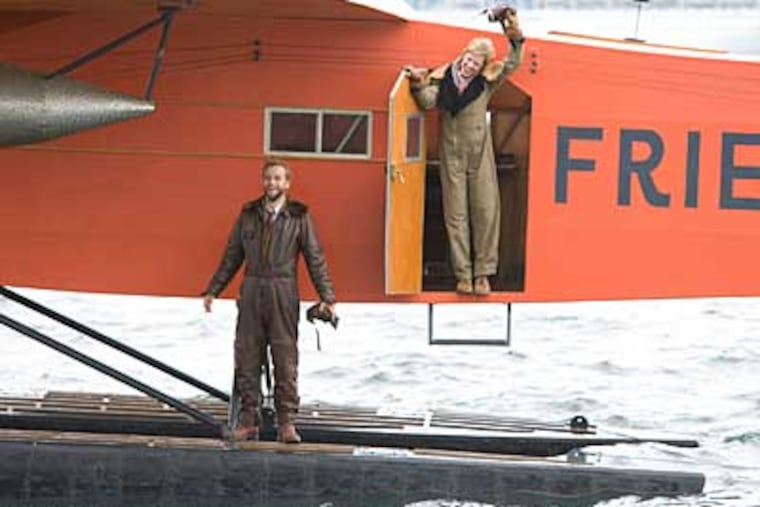Swank soars as flier Amelia Earhart
In The Aviator, Martin Scorsese mythologized Howard Hughes as a 20th-century Icarus who, scorched by the sun, plummeted to earth. In Amelia, director Mira Nair presents Amelia Earhart, legendary aviatrix, as a female Odysseus who navigates uncharted territory while a patient spouse knits his brow until she returns.

In The Aviator, Martin Scorsese mythologized Howard Hughes as a 20th-century Icarus who, scorched by the sun, plummeted to earth. In Amelia, director Mira Nair presents Amelia Earhart, legendary aviatrix, as a female Odysseus who navigates uncharted territory while a patient spouse knits his brow until she returns.
Though this traditional story about a defiantly nontraditional woman doesn't always soar, it fits Hilary Swank, its producer/star, like a jumpsuit. She and Nair thrill to the life of this American who broke records, hearts, and boundaries.
Earhart (1897-1937) first took to the skies in 1920 in a plane that didn't have a gas gauge, brakes, or rear wheels. While the story of her fearless Kansas youth and vagabonding teen years may have added another dimension to her character, the film - written by Ron Bass (Rain Man) and Anna Hamilton Phelan (Girl, Interrupted) - races past her first 30 years.
It begins in 1937, then flashes back to the pivotal year of 1928, when promoter and publishing magnate George Putnam (Richard Gere) auditioned the 30-year-old flier for the role of first female to fly the Atlantic.
Like an ingenue, Earhart got her break when Putnam, who knew the value of novelty when it came to selling books or cigarettes, essentially cast her as the first woman to cross the Atlantic by plane.
In 1928 she took a backseat to male copilots. But soon Earhart took the controls as the first woman to fly the Atlantic solo and first aviator to twice fly the transatlantic route. The public embraced her as it had Charles Lindberg. The media crowned the striking aviatrix "Lady Lindy."
Nair's biopic focuses on Earhart's momentous last decade, one of dizzying motion. Whether setting records in the air, hopping between cities on lecture tours that financed her exploits, or pursuing her heart's desire, she personified what was called the New Woman. Matter-of-factly the film presents Earhart as one who resisted gravity and society's expectations.
Swank's wide-set eyes, toothy smile, and slim-hipped stride lend her an extraordinary resemblance to the aviatrix of period newsreels.
But Swank is no mere impersonator. Her Amelia, like Maggie in Million Dollar Baby, is unwavering in her gaze, ambition, and drive. Swank streamlines Earhart into a figure who stands taller and flies higher than her confreres. In Nair's evocatively art-directed (and sensationally costumed) film, Earhart comes alive.
Gere is sly as Putnam, playing him so that when he beholds his protegee we can't tell if those are hearts or dollar signs glittering in his eyes.
Amelia pointedly details how the promoter turned the aviatrix into one of the first media stars to earn money from product endorsements.
Although she resisted Putnam's initial marriage proposals, Earhart reluctantly wed him - handing him a prenup agreement before the ceremony. She refused to hold him to "any medieval code of faithfulness," expected to enjoy her own freedoms, and made him promise that if the marriage didn't work out after a year he would let her go.
Earhart did enjoy her own freedoms. Whether taking off across new horizons, stumping for female employment in the new field of aviation, or pursuing an affair with Gene Vidal (Ewan McGregor), the aviator father of writer Gore Vidal, she wrote her own agenda, fearlessly.
While the movie is more about the love affair between woman and plane, Earhart came to love Putnam, nicely played by Gere as the wind beneath her wings.
A filmmaker who customarily explores interior landscapes, Nair (Monsoon Wedding, The Namesake) exhilarates in Earhart's perspective, both scenic and existential. Whether looking out on frolicking giraffes or beyond the horizon, Earhart still inspires.
EndText